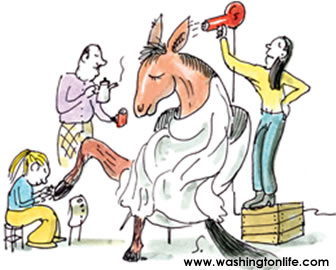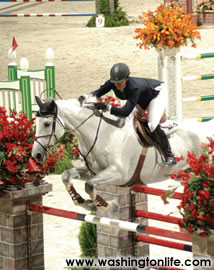MANE ATTRACTION
You thought you have it good: show horses really know what it means to be pampered
BY EMILY GOLD

It’s the morning of an important event, and Maizy Toltien has an early wake-up call. For the past several weeks, she’s been working with her masseuse, acupuncture therapist and personal trainer to ensure that she’s feeling her absolute best for the big day. And now, it’s time to make sure she’s looking her best as well. After a light morning workout and nutritious breakfast, she enjoys a luxurious bubble bath. Then it’s time to primp: while one beautician gets to work making sure that every inch of her is smooth and glowing, another painstakingly styles her hair with impressive intricacy and precision. After hours of primping and pampering, it’s time for wardrobe. Then, after a final coat of polish is applied to her flawlessly manicured nails, she’s ready for the spotlight.
The life of a Hollywood A-list celebrity?
Not exactly. Maizy Toltien is a horse, and instead of getting ready to hit the Academy Awards, she’s preparing for the Washington International Horse Show at the Verizon Center, October 24- 29. It is not unreasonable to draw a parallel, however. The Washington International is the equestrian equivalent of the red carpet. Horses and riders from all over the country compete year round in hopes of qualifying for this prestigious competition, and only the top 30 horses in each division are invited to attend. It is the place to see and be seen, and to face off against the sport’s crème de la crème. The Super Bowl of horse shows, if you will. Naturally, owners and riders are willing to go to extremes to keep their athletes in prime condition for their big day.
THE WASHINGTON INTERNATIONAL HORSE SHOW IS THE EQUESTRIAN EQUIVALENT OF THE OSCARS OR THE SUPER BOWL OF HORSE SHOWS OWNERS AND RIDERS ARE WILLING TO GO TO EXTREMES TO KEEP THEIR ATHLETES IN PRIME CONDITION
Preparation for a competition like the Washington International begins weeks, even months, in advance. Every equine professional has a unique method for mentally and physically readying their four-legged charges for such an event. A fitness regiment is essential to success. In addition to regular exercise, many horse owners turn to equine massage therapy for added edge. “Horses can experience much of the same tension, stress and anxiety issues that humans do,” says Katie Boyer, a licensed equine massage therapist from Harmony, Pa. “The equine athlete is composed of 60 percent skeletal muscle which can benefit tremendously from massage. Not only does massage increase range of motion and enhance muscle tone, it can also improve the general disposition of the horse.”
Similarly, acupuncture is becoming an increasingly popular practice among horse owners. Acupuncture involves the stimulation of anatomical points through the use of various techniques, most commonly through the use of thin needles. This stimulation allows the therapist to pinpoint and alleviate areas of discomfort. Other popular performance-enhancing techniques include magnetic therapy, heat/cold therapy, and even animal communicators, or “horse psychics.”
A week or so before the big event, preparation begins to intensify. A farrier, or blacksmith, comes to tend to the horse’s hooves. A healthy, well-balanced hoof is vital to soundness and performance. Prior to competition, the farrier trims off any excess hoof (the equine version of the mani-pedi) and fits the horse for new shoes if necessary.
At this time, the horse is also “shaved” to remove unwanted hair from the muzzle, ears and legs. This creates a sleeker, more finished look that is pleasing to the eye. The horse’s mane is thinned and shortened, and the tail is conditioned and detangled. By this time, the horse is in top physical condition and ready to go.
 |
The night before the big day, the horse is shipped into downtown Washington, where temporary stalls have been erected on the streets around the Verizon Center. After settling in, horse and rider are assigned a time to go into the arena for “schooling,” an opportunity to ride in the ring and allow the horse to acclimate to its new surroundings. After schooling, the horses are groomed, fed and put into their assigned stalls all of which are amply stocked with bedding, hay and fresh water to ensure the horse is comfortable in its home away from home. Most owners opt to bandage their horse’s legs to prevent swelling and offer support for the tendons. Then it’s time for a good night’s sleep, with security standing guard.
The day has finally arrived! Work begins early with a light exercise session, followed by a hearty breakfast. Then it’s bath time. At this level of competition, most horses have a groom, which is essentially a personal assistant to ensure that the horse is properly prepared and looks its best. The groom bathes the horse, making sure that every inch of the animal’s coat is spotless and shining. Up next: hair. A braider, roughly equivalent to a horse stylist, will style the mane into anywhere from 20 to 50 small, tight, identical braids, depending on the size of the horse and the length and thickness of the mane. Once the mane is finished and flawless, the braider sets to work on the tail, which is styled in a modified French braid on the top and flowing free on the bottom for a classic and sophisticated look. After hair comes wardrobe, at which time the groom will dress the horse in its saddle and bridle. Right before performance time there is a final grooming to remove any dirt and dust, a coat of polish on the hooves, and then it’s time to go. The gates to the arena open (the metaphorical opening of the limo door), the crowd grows quiet, cameras begin flashing, and, finally, all the work has paid off. |


